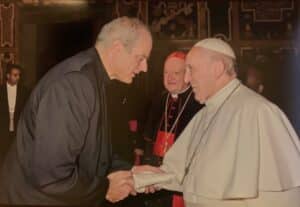“Jesus came and stood in their midst and said to them, ‘Peace be with you.’” — John 20:19
The Gospel for this Second Sunday of Easter brings us into the upper room with the disciples. Locked in fear, unsure of the future, grieving what they thought was lost—until the Risen Lord appears among them with one stunning word: “Peace.” This peace is not an escape from reality, but a gift that enables them to face the world with courage. He then breathes the Holy Spirit on them and commissions them to go forth with mercy, forgiving as they have been forgiven.
It is fitting that this Sunday is also Divine Mercy Sunday, a day rooted in the revelations to St. Faustina and affirmed by St. John Paul II. But this year, it takes on even deeper meaning for us as we mourn the passing of Pope Francis, who returned to the Father this week at the age of 88. His entire papacy was an embodiment of this Gospel encounter: he stood in the midst of a fearful and wounded world and spoke of God’s infinite mercy—over and over again.
A Field Hospital for a Wounded World
Pope Francis began his pontificate with the now-iconic image of the Church as a field hospital after battle, saying in 2013:
“I see the Church as a field hospital after battle. It is useless to ask a seriously injured person if he has high cholesterol and about the level of his blood sugars! You have to heal his wounds. Then we can talk about everything else.”
He invited us to imagine the Church not as a gated institution for the perfect, but a refuge of mercy for the wounded—a place of encounter and healing. This image shaped his call to Catholics everywhere: get out of the sacristy, step beyond your comfort zone, and bring the love of Christ to the existential peripheries of society—where people feel abandoned, excluded, or judged.
Many Faces, One Body: The Polyhedron
And yet Francis knew that being a field hospital wasn’t enough—we also needed a new way of thinking about what it means to be Church in a globalized, pluralistic, and ever-changing world. For this, he drew on another rich metaphor: the polyhedron.
In his 2013 exhortation Evangelii Gaudium, Francis rejected the idea of the Church as a pyramid or sphere—where every point is equidistant from the center and all difference is flattened. Instead, he wrote:
“The image of the polyhedron can express the convergence of all the varied gifts and richness of people, while remaining distinct and unique. It reflects a Church that is united, but not uniform.”
A polyhedron, like a soccer ball or a crystal, is made up of many facets—each with a unique shape, all connected, none dominant. For Francis, this symbolized how the Church should embrace the diversity of cultures, charisms, ministries, and people, rather than demand conformity. It is in this diversity that the Holy Spirit reveals the fullness of the Body of Christ.
A Synodal Church: Listening, Walking, Discerning
This vision was not theoretical—it became the foundation of his most ambitious ecclesial reform: the Synod on Synodality, launched in 2021. For Francis, synodality is not a program or event—it is a way of being Church. It means walking together, listening to one another, discerning the voice of the Spirit in community. As he wrote:
“A synodal Church is a Church which listens… It is a mutual listening in which everyone has something to learn.”
This is not about changing who we are—Jesus Christ remains our constant, our cornerstone. But it is about changing how we are, how we relate to one another, and how we carry out the mission of the Church. We are called to dynamically adapt our ministries so that people in every generation and every context can encounter Christ—in their language, in their wounds, in their hopes.
Francis modeled this in how he reimagined leadership, elevated the role of laypeople, listened to the voices of youth, women, migrants, Indigenous peoples, and those who have long felt unseen, especially the divorced and remarried, the members of the LBGTQ+ communities, the immigrants and refugees, the poor and homeless and others on the marginalized existential peripheries of society. He reminded us that the Holy Spirit speaks through the whole People of God, not just through hierarchical structures.
Our Vision at St. Simon: Many Faces, One Mission
Here at St. Simon Parish, we’ve been listening too. Over the past few years, we’ve engaged in our own synodal process—through parish surveys, listening sessions, and countless conversations. We’ve heard the dreams, struggles, and faith of our community. And now we’re ready to respond—with a bold new vision for our future.
We believe God is calling us to be both field hospital and polyhedron—a parish that meets people where they are and reflects the richness of who they are. A place where diverse ministries serve a common mission: to love, to heal, and to lead all into deeper relationship with Christ.
We invite every parishioner to join us for one of two Parish Town Hall Gatherings, where we will unveil this vision:
- Tuesday, May 20th, 7:00 pm, Spooncer Hall
- Tuesday, May 27th, 7:00pm, Spooncer Hall
Come and help us shape the next chapter. Come and walk with us, just as Pope Francis walked with the world—with courage, humility, mercy, and joy.
As we say goodbye to our Holy Father, may we carry his legacy forward:
to be a Church of many faces, but one heart;
a Church that listens and loves;
a Church that proclaims, in every generation,
“Jesus, I trust in You.”
May Pope Francis rest in peace—and may the Spirit now stir us to live his vision.
A Word of Gratitude
Before closing, I want to express my heartfelt gratitude to everyone who participated in our Holy Week and Easter Sunday celebrations. It was truly wonderful to see so many of you at church—your presence enriched and enlarged my heart in ways I cannot fully express.
I am particularly grateful to all the ministers who served so faithfully throughout the week—the list is too long to mention by name, but I must give special thanks to Erika Ibarra, our Liturgical Council Chair, for her tireless work coordinating so many aspects of our liturgies. I am also deeply grateful to Clare D’Agostino and all our Pastoral Staff who played such essential roles in planning, executing, and prayerfully supporting each service. In a special way, I want to recognize Meredith Augustin for her extraordinary leadership and dedication in planning and coordinating the music and liturgical flow throughout the entire week.
It was a beautiful witness of our Church coming together to celebrate the core of our faith: the passion, death, and resurrection of Jesus Christ. Thank you all!
God bless
Fr. Brendan


